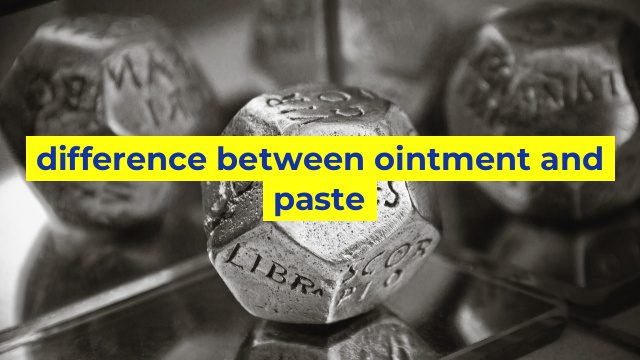Knowing the Difference between Ointment and Paste: Which One Should You Use?
When it comes to taking care of our skin, ointments and pastes are among the most commonly used products. These topical formulations are designed to help alleviate skin conditions such as rashes, burns, dryness, and itchiness. However, many people confuse one with the other, not knowing that there are significant differences between the two. So, what differentiates an ointment from a paste, and which one should you use for your skin condition? Let us take a closer look.
What is an Ointment?
An ointment is a semisolid preparation that is composed of a mixture of oils and waxes that can be easily spread on the skin. It is usually smooth, greasy, and translucent, and provides a barrier over the skin that helps in preventing moisture loss. Ointments often contain active ingredients such as antibiotics, corticosteroids, and antifungal agents that help treat various skin problems. They are generally used for conditions such as eczema, psoriasis, or dermatitis.
What is a Paste?
On the other hand, a paste is a semisolid preparation that is generally thicker and less greasy than ointments. Unlike an ointment, a paste is typically made up of a combination of powdered or granulated substances and a liquid or semisolid base, such as petroleum jelly. Pastes may contain ingredients such as calamine, zinc oxide, and glycerin, which can be useful in treating skin irritations, burns or wounds.
Which One Should You Use?
The choice between ointment and paste largely depends on the type and severity of the skin condition being treated. In general, ointments are best suited for dry or scaly skin conditions that require a barrier effect, while pastes come in handy when dealing with wet or weeping skin conditions. Ointments are more occlusive than pastes, meaning that they stay on the skin surface longer, are less prone to rub off or wash away, and provide better hydration than powders or creams.
In addition, ointments tend to have a more prolonged effect than pastes, and they are generally more effective in delivering active ingredients into the skin. As a result, ointments tend to be more expensive than pastes. If you have an oily or acne-prone skin condition, you may want to avoid using ointments, as they can clog your pores and trigger breakouts.
Wrap Up
In summary, ointments and pastes are both relevant drug formulations that can be used to treat a variety of skin conditions. While they may look similar, they have significant differences in terms of composition, texture, application, and efficacy. Knowing the difference between ointments and pastes can help in choosing the right product for your skin condition, improving its treatment response, and preventing unwanted side effects.
Table difference between ointment and paste
| Type | Definition | Texture | Uses |
|---|---|---|---|
| Ointment | Medication mixed with oil or water base | Thick and greasy | Used to treat dry, scaly, or itchy skin conditions |
| Paste | Medication mixed with a base of petrolatum or zinc oxide | Thicker and more powdery than ointments | Used to treat wet or weepy skin conditions |


